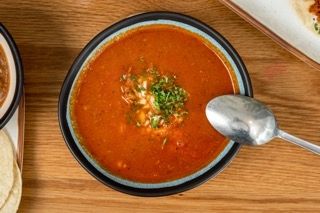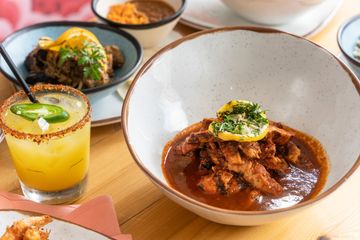Discover why churros are a must-try after every Mexican meal
Discover the Rich Flavors of Mexican Food: A Trip Via Its Popular Dishes
Mexican cuisine provides a tapestry of flavors and customs that show its abundant social heritage. Each recipe, from the precious tacos to the intricate mole, carries its own story and importance. The diverse active ingredients and food preparation techniques highlight regional variations and common eating experiences. As one discovers these preferred dishes, the depth and variety of this culinary landscape ended up being significantly noticeable, welcoming curiosity about what lies beyond the surface of these renowned flavors.
Tacos: The Ultimate Mexican Road Food
Tacos, commonly pertained to as the quintessential Mexican street food, embody the abundant culinary customs of Mexico. These scrumptious developments consist of a soft or crispy tortilla full of a range of components, showcasing a range of flavors and appearances. From tasty meats like carnitas and al pastor to vegan options including beans, cheese, or smoked veggies, tacos use something for each taste buds.
The simplicity of the taco enables endless customization, often covered with fresh cilantro, onions, salsas, and lime. Road vendors throughout Mexico skillfully prepare tacos, offering them warm and fresh to enthusiastic customers. The public nature of taco usage promotes a sense of link among diners, as they share varied fillings and toppings.
This precious recipe not only stands for the culinary virtuosity of Mexico however also functions as a symbol of social identity, mirroring the dynamic spirit of the nation's food scene. best mexican westchester NY.
Enchiladas: Rolled Enjoy a Flavorful Sauce
Enchiladas stand for a rich practice in Mexican cuisine, showcasing a selection of components and local adjustments. The preparation of these rolled tortillas, usually full of veggies, meats, or cheeses, entails particular food preparation methods that boost their flavor. Recognizing the nuances of both cutting-edge variations and standard parts can raise the enchilada experience.
Traditional Active Ingredients and Variations
Among the quintessential meals of Mexican food, enchiladas are commemorated for their versatility and rich tastes. Commonly, corn tortillas act as the base, often full of a range of active ingredients such as shredded hen, beef, cheese, or beans. The fillings can be complemented by a range of sauces, ranging from red chili to eco-friendly tomatillo, each adding its one-of-a-kind preference. Variants are plentiful throughout areas, with some including neighborhood ingredients like seafood in coastal locations or mole in Oaxaca. Garnishes may consist of sour lotion, avocado, cheese, or lettuce, improving both flavor and discussion. This versatility allows enchiladas to reflect the varied culinary heritage of Mexico, making them a beloved selection for lots of.
Cooking Strategies and Tips
Grasping the art of preparing enchiladas involves understanding different cooking strategies that improve their flavor and structure. Choosing the appropriate tortilla is necessary; corn tortillas are standard and offer authentic preference. When rolled, they ought to be gently heated to avoid cracking. The dental filling, typically a mix of meats, cheese, or vegetables, must be experienced well to instill flavor. Once loaded, enchiladas are rolled firmly and positioned in a baking meal. A flavorful sauce, green or normally red, ought to be put generously over them prior to baking. Cooking allows the tastes to meld and celebrity to thaw magnificently. Garnishing with fresh toppings like cilantro, onions, or sour lotion adds a burst of quality, elevating the meal to brand-new heights.
Mole: The Intricacy of Mexico's Trademark Sauce
Mole stands apart as a perfect element of Mexican food, showcasing an abundant tapestry of ingredients and regional variants. This complex sauce not only improves recipes but likewise personifies deep cultural relevance and practices that have been passed down with generations. Recognizing mole calls for an appreciation of both its diverse components and its role in celebrations and everyday life.
Ingredients and Variations
A characteristic of Mexican food, mole showcases an abundant tapestry of active ingredients and local variations that reflect the country's diverse culinary landscape. Usually, mole incorporates a selection of chiles, seasonings, nuts, seeds, and delicious chocolate, creating a complex flavor account. One of the most well-known version, mole poblano, comes from Puebla and attributes components like ancho and pasilla chiles, almonds, and dark chocolate. Other local ranges, such as mole negro from Oaxaca, stress various spices and techniques, resulting in distinct preferences and textures. Some moles might include fruits, natural herbs, or perhaps regional specialties, even more improving their originality. This adaptability allows mole to be a versatile enhancement for numerous meals, especially meats, showcasing the depth and richness of Mexican cooking practices.
Cultural Importance and Traditions
While often commemorated for its abundant flavors, mole also holds deep cultural relevance in Mexican society, serving as a sign of heritage and practice. This complicated sauce, with its mix of components and techniques, shows the historical blend of native and colonial impacts. Generally, mole is prepared during significant parties, such as wedding events and spiritual vacations, showcasing its role in public events and family members links. Each region flaunts distinct variants, even more stressing regional pride and identity. The act of making mole can be viewed as a ritual, gave with generations, enhancing familial bonds and social continuity. Mole transcends plain nourishment; it personifies the spirit and resilience of Mexican culture, making it a valued culinary work of art.
Tamales: A Practice Wrapped in Corn Dough
Tamales stand for a valued tradition in Mexican food, personifying both cultural relevance and cooking artistry. These wonderful parcels are made from masa, a dough stemmed from corn, which works as a canvas for a range of dental fillings, such as meats, cheeses, or vegetables. tacos. Covered in corn husks or banana leaves, tamales are steamed to excellence, permitting the flavors to combine magnificently
Historically, tamales have actually been enjoyed for centuries, typically prepared throughout cheery celebrations and family gatherings. They symbolize neighborhood and togetherness, as the process of making tamales is often a common task, with household participants integrating to share techniques and recipes. Each region of Mexico boasts its unique variations, showcasing the diversity of lunch and dinner ingredients and local customizeds. Whether served with salsa or delighted in by themselves, tamales stay a cherished dish that continues to connect generations, celebrating both heritage and the abundant tapestry of Mexican cooking practices.
Ceviche: Quality From the Sea
Ceviche, commemorated for its lively flavors and invigorating qualities, stands as a demo of the bounty of the sea in Mexican cuisine. This meal generally features fresh fish or seafood, seasoned in citrus juices, largely lime, which successfully "cooks" the protein while instilling it with a spicy illumination. Typically combined with ingredients such as cut onions, tomatoes, cilantro, and chili peppers, ceviche uses a harmonious blend of appearances and flavors that capture the significance of coastal living.
Regions throughout Mexico have their own variations, showcasing neighborhood seafood and unique seasoning mixes. For example, in the Yucatán Peninsula, ceviche is often coupled with avocado and experienced with a hint of orange juice for an exotic twist. Offered chilled, this recipe is not only a favored appetizer yet likewise a rejuvenating alternative on warm days, personifying the spirit of event and community discovered in Mexican cooking customs.
Chiles Rellenos: Stuffed Peppers With a Kick
Chiles Rellenos exhibit the strong and varied flavors that define Mexican cuisine, much like ceviche showcases the quality of the sea. New York Times rated. These packed peppers are traditionally made with poblano or Anaheim peppers, which are meticulously roasted to boost their flavor and scent. As soon as peeled, the peppers are loaded with a tasty mix, typically consisting of cheese, meat, or beans, creating a fascinating medley of preferences and appearances
After being stuffed, the chiles are generally dipped in a light batter and fried up until gold brownish, adding a rewarding problem. They are often served with a rich tomato sauce or salsa, further boosting their taste profile. This dish is a preferred in lots of Mexican houses and restaurants, embodying the dynamic spirit of the food. Chiles Rellenos not just please the taste yet also showcase the culinary artistry included in producing standard Mexican recipes that commemorate both warmth and taste.
Guacamole: The Creamy Avocado Dip That Swipes the Program

Its adaptability allows it to enhance different dishes, from tacos to smoked meats, while likewise serving as a dip for tortilla chips. The prep work can range from a simple mash to an extra fancy variation with included ingredients like garlic or pomegranate seeds.
Guacamole is usually connected with social gatherings, boosting the experience of sharing food. Its popularity has actually resulted in numerous variants, but the traditional recipe stays a beloved home cooking. Ultimately, guacamole exhibits the heart of Mexican cooking customs, charming tastes buds with each luscious bite.
Often Asked Inquiries
What Are the Main Contents in Traditional Mexican Food?
Typical Mexican cuisine largely features corn, beans, chilies, tomatoes, and different natural herbs and spices. In addition, ingredients like avocados, lime, and meats such as poultry and pork add to the diverse flavors and structures.
Just How Has Mexican Cuisine Influenced Various Other Culinary Traditions?
Mexican food has significantly affected global culinary practices via its dynamic use strategies, ingredients, and spices. Aspects like corn, chili, and beans have actually incorporated right into numerous recipes worldwide, enriching flavors and encouraging fusion cuisines.
Are There Vegetarian Options in Mexican Cuisine?
Yes, Mexican cuisine provides many vegan choices, consisting of recipes like chiles rellenos, enfrijoladas, and numerous tacos loaded with veggies or beans. These options display the lively flavors and active ingredients offered in traditional Mexican food preparation.
What Regions of Mexico Have Distinctive Culinary Designs?
Distinct cooking styles in Mexico arise from various areas, including Oaxaca recognized for its mole, Yucatán with its citrus flavors, Puebla famed for chiles en nogada, and Baja The golden state highlighting fresh seafood and ingenious dishes.
Exactly How Do Traditional Mexican Food Preparation Methods Differ From Modern Techniques?
Typical Mexican cooking techniques highlight slow, communal prep work, utilizing clay pots and open flame, while modern strategies usually include sophisticated equipment and faster cooking times, reflecting a mix of heritage and contemporary culinary techniques.
